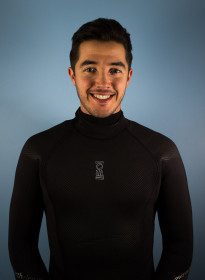 Michael Osborne volunteered with Blue Ventures in Belize in November 2015. You can read lots more about his experience – from hitting the books to hitting the water – on his own blog. Despite the sand flies Michael is a strong advocate for the BV experience and happy to answer any questions you might have about life as a BV volunteer.
Michael Osborne volunteered with Blue Ventures in Belize in November 2015. You can read lots more about his experience – from hitting the books to hitting the water – on his own blog. Despite the sand flies Michael is a strong advocate for the BV experience and happy to answer any questions you might have about life as a BV volunteer.
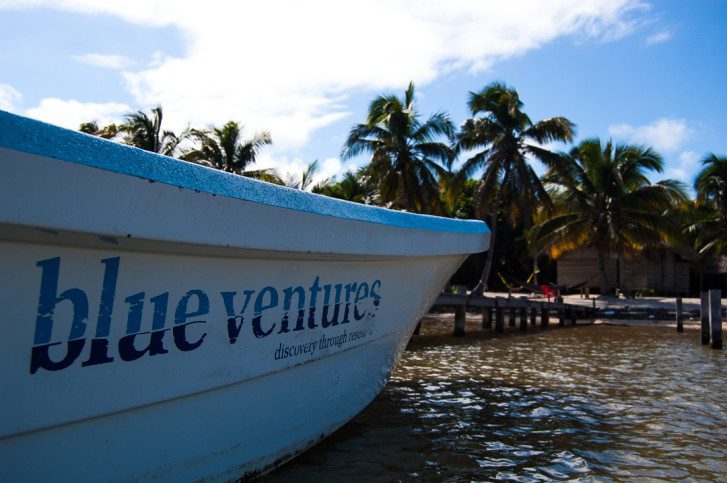
6:30am Riding out over white-capped waves in the light of a golden sun, barely risen. Descending beneath its warm touch in a miasma of bubbles. Parrot fish and Grunts teasing from view as you glide through the warm ocean.
I have recently returned from a 6 week expedition in Belize, Central America, and spent 2/3 of this time at a remote dive camp in the Bacalar Chico Marine Reserve. This site is nestled in the Belize Barrier Reef, which makes up the majority of the Mesoamerican Barrier Reef; the largest reef system in the Atlantic (and 4th longest reef in the world at 585 miles, behind the New Caledonia Barrier Reef [932 miles], the Red Sea Coral Reef [1,180 miles] and the Great Barrier Reef [1,553 miles]1).
[Tweet “Being in a remote location such as this was an entirely new experience for me.”]
Being in a remote location such as this was an entirely new experience for me. Not only was I in a new environment, with new people, doing activities I had never done before, I was also… without the internet! Being removed from the incessant distractions that constantly “bing” and bzzz at you all day was a great part of the expedition. Of course I missed family and friends and all the commodities of modern life, but being removed from some of our daily distractions has affirmed to me our need to be engaged with the moment around us more, rather than just in the reflection of a text message.
8:30am Food’s reeaddyy! Oats? Not today. Eggs, refried beans and Fried Jacks – Can someone grab the hot sauce
Being an excitable, yet introverted person (until I feel comfortable with the people I am with), I originally imagined that a small number of people on an expedition would be best. We numbered 14 volunteers at our most, and actually – the more the merrier! Having a larger group meant there was always someone to talk to, to play cards with, or volleyball with (bring it on!), but equally taking yourself away for some quiet time was always a possibility. It also meant sharing chores over more people, which is definitely not a bad thing when you have to clean the toilets.
Among the chores of camp life was to rake the beach every morning before the day started. With a 6:30am dive kicking things off (weather dependent, of course), that meant getting up around 5:30am to rake the beach in time to attend pre-dive meetings…or go back to bed if you weren’t diving! Of all the chores, I think this was the most valued. Calm weather brought great diving conditions, but flying on the lifeless wind came the sandflies. Little winged demons. Their bites turned my legs into a mass of chicken pox-like, itchy blotches – “Stop itching!” Raking the beach was one of our best defences at disturbing their eggs and limiting their populations from exploding. Our other defence was to smother one’s self in copious amounts of baby oil. Any outsiders happening upon our camp could be forgiven at thinking they had wondered into a Mr/Miss Universe training camp, with the amount of oiled up bodies wondering around.
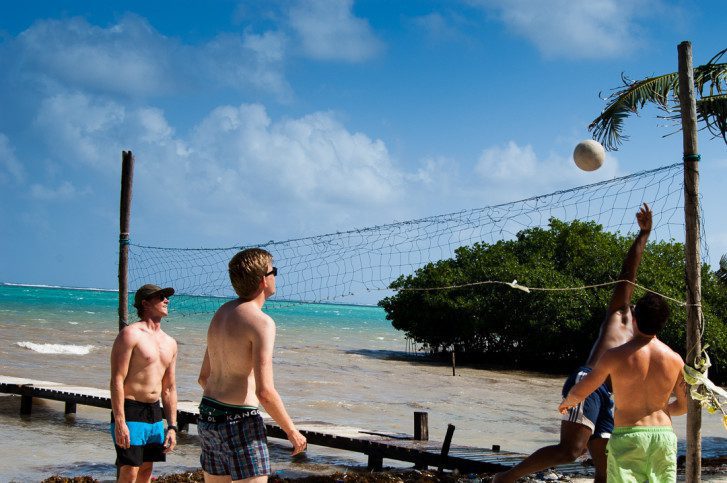
9:30am Kitting up under the shade of our class room, while the sand heats up under the morning sun. The sandflies are not so aggressive anymore, although we all show signs of the dawn raid. Time for the second ride on the waves, the second rush of the wind, the second dive of the day.
The first part of our expedition was primarily dive and science training, so that we could actually conduct the surveys we were there to do. This encompassed computer-based and in water-based tests, which although tedious at times, really helped to immerse us into the work we were doing and heighten our experience – that’s not just another fish swimming by, but a juvenile yellowtail damselfish (Google them, they’re super pretty!). I found that having an understanding of what I was seeing really gave me an appreciation of the wildlife. The most unforgettable moment I had during my dives was seeing my first Loggerhead turtle; unfazed by our descent into its world it crested the top of a patch of coral, swimming into view and splitting our group in two, it paddled between us and continued off over the reef.
Once we had completed our training we began performing our survey work. At our dive camp we were recording fish and coral species (if you haven’t guessed, I was team fish – go fish!) to build up a dataset of the abundance and health of the marine life at specific sites over time, and ultimately an understanding of the reef health and what might be done to help improve it. Forty percent of the Mesoamerican reef is currently in a poor condition2, and work like this should help to identify ways of improving it. I was also given the opportunity, along with another volunteer, to take part in Lionfish surveys with two Blue Ventures interns. These surveys were conducted around the reefs off San Pedro, and by assessing Lionfish numbers and competing species we aim to monitor the effect the Lionfish invasion is having in their new territories.
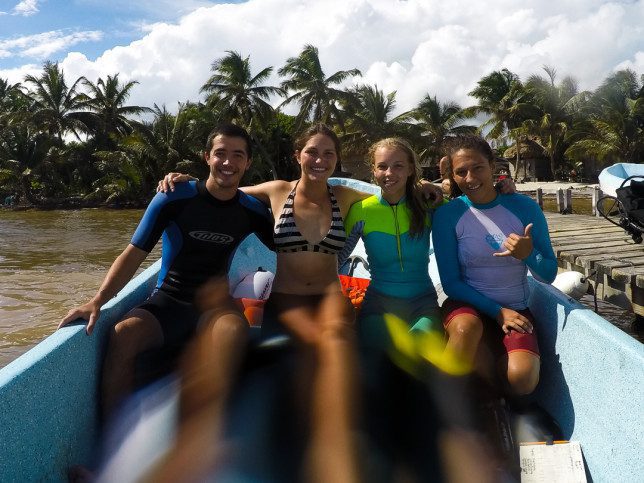
11:30am Gearing up for the last time today. Wet wetsuits on and marshals at the ready. We march in line, feet sinking softly in the warm sand, under the weight of the tanks on our backs. Into the boat, kit at our feet and smiles all around as the jungle whips by in the distance and the waves breaking over the reef approaches. Once down in the depths I turn upside down and watch my bubbles fly to the distant shimmer above…
Although we planned for three dives a day, this was always weather dependent. Sometimes dive times would change or cancel, and we would not all be on every dive. However, not diving did not mean nothing to do. Weeeell, sometimes it did, then relaxing in a hammock became your duty for an hour or so. Otherwise, you might be on shore marshal duty; manning the radio and keeping track of the boats, or on boat marshal duty; accompanying the divers out on the boat to help move kit and aid the divers with anything they needed.
1:30pm Food is ready! The familiar call sounds out again from the kitchen, and we all enthusiastically migrate into the classroom to eat. One by one we grab a set of cutlery and a plate from the side, then sit at our communal benches to feast on chicken soup with rice.
2pm The afternoon sun is beating the energy from us and we begin to feel tired in the way that a good meal can do. So we resign to a few hammocks set up around camp and siesta the next hour away.
The afternoon at camp was typically reserved for some down time as well as further science and dive training, as necessary. We were also scheduled, one person at a time, to work with the compressor to fill our oxygen tanks so that we kept up with our scuba-driven demand. The afternoon was also a good time for data entry and filling in log books – I totalled a bit over 1,000 minutes dive time during our stay at camp (including both my Open and Advanced Water PADI courses)! Alongside the fish and coral surveys we performed, there was also time set aside for bird and manatee surveys – trekking out through the jungle or riding our boat among the mangroves helped to satiate the explorer within me (who had stirred during our adventurous dives).
[Tweet “Six weeks away is a long time, but I am glad for every day of it”]
Day seven at camp was always a day off to help our bodies recover from the week of diving and to give the staff time off – this meant it was our turn to cook for the camp too! We would take it in turns, one cabana team per meal, to feed the camp. Not willing to lose face, meals were often adventurous creations including sweet deserts that probably meant more time spent in the kitchen than absolutely necessary.
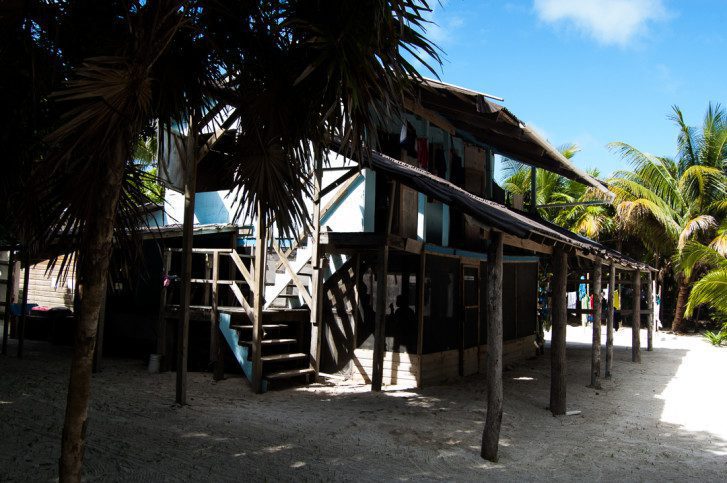
6:30pm The final call of food for the day and we gather, well trained, at the kitchen door. Used to the routine now we check everyone has joined us and together we eat and chat and enjoy.[/pull_quote_center]
The expedition started as it went on to finish, with a week (or so) in the north Belizean village of Sarteneja. Each of us were lovingly looked after by a homestay family who ensured we were well fed and well rested. During our time here we prepared and performed at a community day fete where we demonstrated and discussed the recent rise of the Lionfish and what they are doing to the Caribbean waters. Engaging with the school children was a highlight of the trip, to see their enthusiasm for the work we were involved was delightful (even if they were somewhat coerced with sweets!).
Looking back over the expedition, six weeks away is a long time, but I am glad for every day of it. Not to be forgotten, the life of an expedition is something I would love to come back to again.
9:30pm Running from 4:30pm until now, the generator turns off and the torches turn on as people finish up before bed. The 4 of us in our cabana climb into our respective bunks and tuck in our sandfly nets. The net barricades the breeze outside; it does not reach the bed. In this hot and humid place we drift off to sleep, wrapped in the warmth of the air, like the ocean of the night.
Find out more about our volunteer expeditions in Belize, Madagascar and Timor-Leste or find out more about why the volunteer ecotourism model works for conservation.

